1975 East German Trabant
He Owned One Behind the Iron Curtain Several Decades Ago. Now They Buzz Around California, Not the Autobahns.
I WENT INTO THIS assignment fully prepared to snicker up my sleeve at the Trabant (Trah-bahnt) — an East German car built during the communist era. It is also known by its nickname Trabi. I couldn’t imagine why someone would want to import such a machine to the United States, and one look told me that beating up on the Trabant would be taking candy from a baby. But the downside is it wouldn’t be very original because it has been done in the automotive press repeatedly over the years.
None other than Time magazine rated the Trabant as one of the 50 worst cars ever built; but I think that may be a bit harsh when you consider that more than three million of them were produced over a 30-plus year period, and that the typical Trabi lasted an astounding 28 years. I can think of cars I won’t mention that couldn’t last three years even with the best of care.
Small and Slow, but with a Long Production Run
For the record, Trabant is a German word for satellite or moon, and the Trabant debuted about the same time as the Sputnik. The word also means companion. The car came out in 1957 as the Trabant P50, also called the Trabant 500, because of its 500cc engine. This early model had a somewhat different, cleaner look than the later 600 that debuted in 1962. The 600 remained in production until 1964 at which time it was modestly updated, given a bigger engine, and became the 601.
The 601 continued in production for over 20 years substantially unchanged, and in its final days — prior to German re-unification in the late 1980s — the Trabi 601 engine put out 26 horsepower and had a 37-cubic-inch displacement. Acceleration was leisurely by American standards, but adequate. The car took 21 seconds to get up to 62 miles per hour, and had a top speed of about 70 miles per hour.
When the Trabant first appeared back in the ’50s, it stacked up reasonably well in comparison with its Western European contemporaries. And I must say that after driving a Trabant 601 Limousine I was favorably impressed with it in many ways, although calling the little two-door sedan a “limousine” borders on preposterous.
In any case, more significant to me than the driving impressions was the fact that I was quite taken by owner Josef Czikmantory’s reasons for importing his example of the marque, and his reasons for loving it.
All Things Considered, the Ride’s Nice…
Getting into Josef’s 1975 Trabant took a bit of folding and crumpling of my 6'2" frame, but once inside I would say that the Trabant is no more cramped than my 1966 Morris Minor or my 1970 Beetle. I turn the ignition key and the 600cc two-cylinder engine bursts into that unmistakable bring gga bingbing two-cycle song, but as it warms up and idles down it settles into a less intrusive popcorn popper sound.
Acceleration from a standing start is good. The engine revs easily and, though noisy, it doesn’t lack for power. There is a subtle vibration from the engine all the time it is running that is reminiscent of contemporary two-cycle Saabs, DKWs and Skodas of the ’50s and ’60s. Two-cycle-engine-powered cars were common in Europe until air pollution became a major concern in the 1970s.
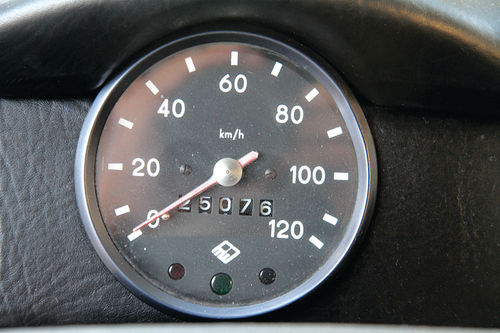
Steering is light and responsive thanks to the car’s low weight. The ride is definitely smoother and less choppy than my vintage Beetle or my 1966 Morris Minor. And you can corner with confidence thanks to the car’s transverse leaf spring four-wheel independent suspension. All in all — except for the buzzy engine sounds — the car is nice to drive. The transmission is a four-speed that is shifted by a lever that protrudes from the dash. It shifts cleanly and precisely, and the clutch is light.
The four-wheel drum brakes are more than adequate thanks to the car’s mere 1355-pound weight and the fact that its top speed on level ground tops out at 70 mph. The handling reminds me of the Fiats and Alfas of the era, and I mean that as a compliment because — whatever else one might say about those marques in the old days — they handled very well.
Two-cycle engines have the twin advantages of simplicity and efficiency because they do not need a cam or a valve train and can produce a lot more power than a four-stroke engine of the same displacement. But they have their disadvantages too, such as producing many times more air pollution than a four-cycle motor. And because every stroke is a power stroke, they wear faster, and need more frequent overhauls.
And finally, the fuel economy from a two-stroke is not as good as a four-stroke engine, though the Trabbi is good for 34-mpg highway due to its diminutive 600cc displacement. (As a comparison, my 1100cc four-stroke Morris Minor gets about the same mileage on the highway.)

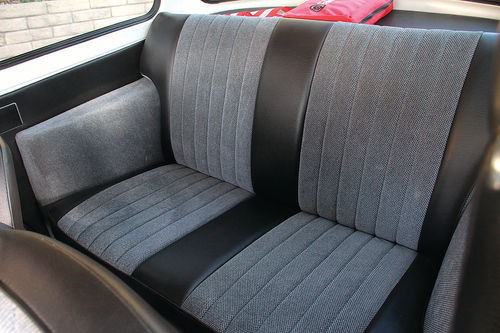
A Lightweight Duraplast Body
The Trabant owes its diminutive weight to a material called Duraplast that is sort of like fiberglass, and was used to make the car’s body. It is very similar to a compound called Micarta that we use in the U.S. to make insulated circuit boards. The Duraplast from East Germany was actually made using recycled cotton fiber or wood fiber and resins. The process has been around a long time; the product is quite durable and doesn’t rust. And lest you think such materials might be flimsy, I can tell you that Micarta is so tough that Chevrolet used it to make the timing gears for their old Blue Flame sixes in the 1950s.
In fact, Duraplast is so durable that Europe has had a problem disposing of old Trabi bodies. Burning them causes toxic pollution, and they don’t seem to biodegrade otherwise. But they do have the virtue of being the only car bodies made of recycled material.
Where’s the Gas Gauge?
Mechanically the car couldn’t be simpler. As we said before, the engine has no valves, pushrods or cam, and in addition to that, there is no fuel pump or fuel gauge either. The fuel tank is under the hood behind the engine, and is gravity fed to the carburetor. There is a plastic dipstick nearby so you can determine how much fuel you have.
The engine has no mixing device for the fuel and oil that it burns and uses for lubrication. So when you put gas in a Trabbi you need to add oil at a ratio of 50:1 each time you fill up. Back when Trabants and other two-stroke cars were common in Eastern Europe, fuel was sold pre-mixed at gas stations.
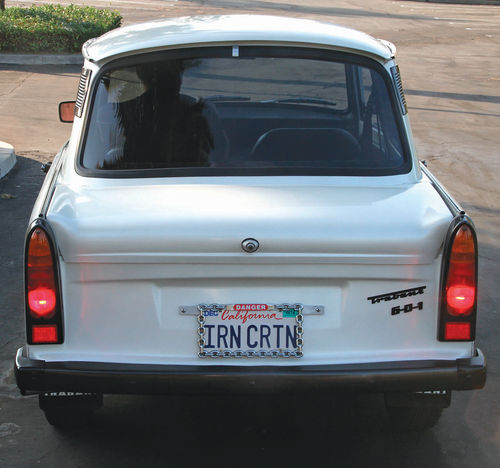
The car doesn’t need an oil pump either, nor a radiator, because it is aircooled. Also, the little motor has no distributor. Instead it relies on two coils that fire alternately. The only American car I can think of that is almost as simple as a Trabbi is Henry Ford’s Model T, and both cars were made simple for the same reason. They both needed to be inexpensive to purchase, and simple to operate in order to reach their intended customers.
World War II had devastated East Germany; and its postwar economy was further hobbled by the communist regime’s inept top-down management, so its people couldn’t afford much, nor was there much available to afford. There was no competition for the Trabant under communism, and any innovation or change to update the car on the part of the East German “workers’ paradise” would have just cost the government more money. Besides, the demand for automobiles was so great that no real improvements were needed over the years in order to sell every Trabi produced.
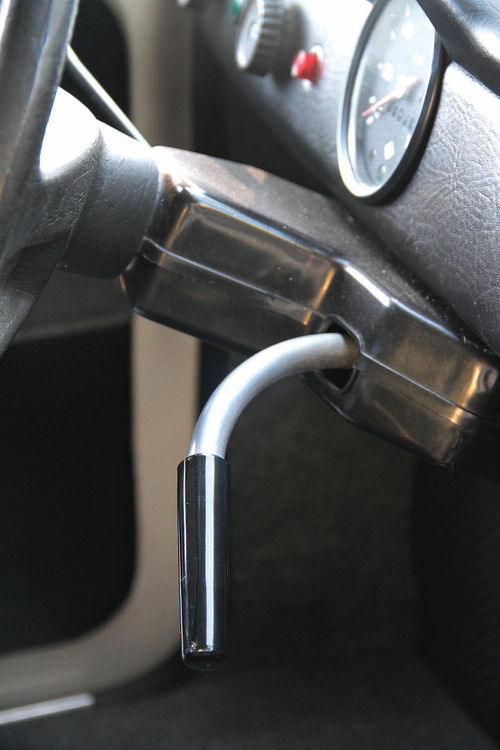
A final manifestation of the Trabant was produced after the reunification of Germany that used a 63.6-cubic-inch VW four-stroke engine which helped with the air pollution and gave the car a bit more power…but by that time, no one on either side of what had been the Iron Curtain wanted an obsolescent Trabi. Consequently, in later years the German countryside was littered with dying and dead Trabants. Of late, however, young motor heads are fixing them up, hopping them up and racing them.
You Paid Your Money and Then You Waited
Josef Czikmantory said that under the communists it could easily take three to five years to get a new Trabant in East Germany. You paid the total price up front, and then the police came out for a visit to establish that you obtained the money to buy your new car by honest means. Then you waited…for years. It wasn’t that unusual for a new car to go to the original buyer’s heirs. Endless shortages, lack of incentive for the labor force, and the labor-intensive bodywork all added to the problems.
Josef’s first Trabant was 19 years old when he purchased it, and even then he paid more than the cost of a new one. But he was able to buy it without an investigation and without a waiting period. However, because his car was getting along in years, and because he was not a wealthy man, he had to learn how to repair and maintain the car himself. As luck would have it though, he could handle that sort of thing easily because he’s a mechanical engineer.
Josef’s first car meant a taste of personal freedom and—as it turned out years later — a Trabant actually transported him to political and economic freedom too. But well before Czikmantory escaped to the West in 1986 in a Trabbi, he and his wife toured all over Eastern Europe in his original one. “Those were some of the happiest times of my life,” Josef said. “Because of that I know how to work on a Trabant, and it brings back so many memories.”
(I understand why Josef imported an old Trabant. My wife and I toured the United States, Canada and Mexico in a 1957 Chevrolet Pickup truck 40 years ago. I now own a 1958 Apache, partly so I can relive some of those fond memories. My old hauler is not handsome or impressive, nor is it fast or even particularly comfortable, but it makes me feel good to drive it.)
He’d Grown Accustomed to His Trabi
Josef tried to escape to the West several times. It was tricky business, and people died trying. But his lucky break came in 1986. He was born in Romania but speaks Hungarian like a native, so he thought he would try getting out through Hungary rather than Berlin’s Checkpoint Charlie. He drove to a lonely border outpost in the mountains between Hungary and Austria. There was only one young border guard on duty, and he was standing around in front of his guard shack smoking a cigarette.
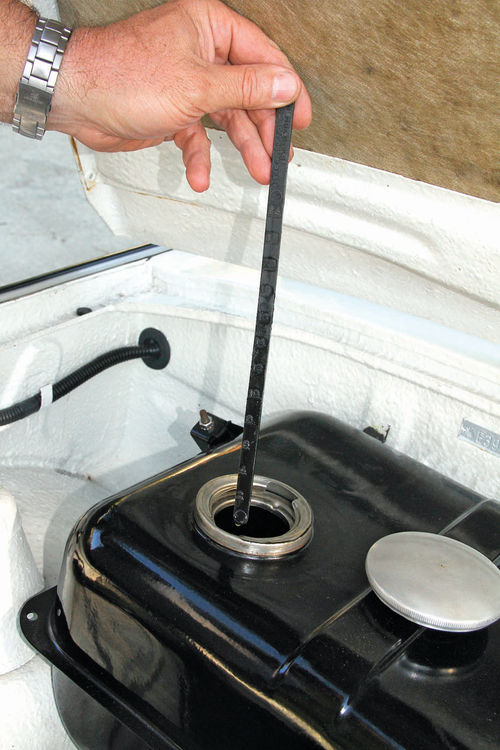
Josef stopped the car and walked up to him for a chat. He told the guard in Hungarian that he wanted to pop into Austria to visit family. They chatted for a while longer, and then the guard said, “Go ahead,” and motioned him on through. It worked!
Josef couldn’t believe his luck. He was free! And like a lot of other escapees, he ditched his Trabi for a nicer car as soon as he could. …But then he started missing it.
A SoCal Trabant
Czikmantory immigrated to the United States later, but he still missed his little Trabant, so he imported one.
Purchasing this 1975 Trabi back in Germany was no problem, and getting it into the country was easy. But getting it past California’s strict smog laws and Department of Motor Vehicles bureaucracy was a bit of a hassle. It all worked out in the end though.
Now Josef can drive around Southern California in his nimble little Eastern Block car, listen to the nostalgic “binga bing bing” of its two-cycle engine, and marvel at how much enjoyment his little Trabant brings him and the people who see it at shows. He has dolled it up and personalized it a bit, but it is basically restored to stock.
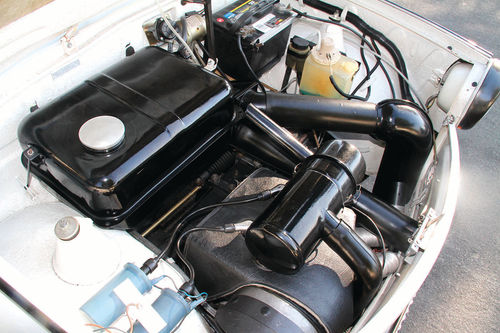
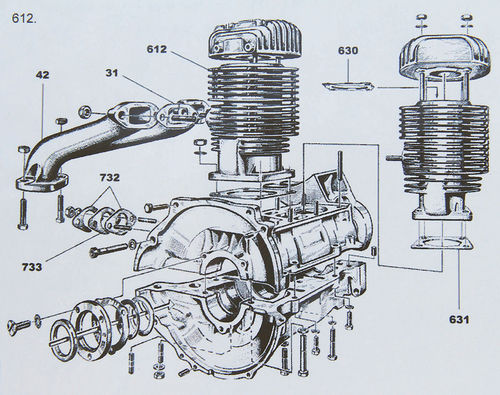
As for replacement parts, tires are in the same dimensions as here, despite the fact that most of the car is metric. Other parts are plentiful in Europe because the cars were made unchanged for so many years, and he has family members there to help him with his component searches.
One Definite Retro European Image
The car is cute and stubby in a typically European way.
I can easily picture Peter Sellers, playing Inspector Clouseau in a Pink Panther movie, getting into a chase through Paris in a Trabbi.
It’s not a bad-looking little car, but it is small and stubby by American standards, and its styling is very ’60s.
Still, if it were trailing a wisp of blue smoke as the Inspector flew by that would just complete the picture.
















